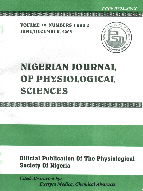
|
Nigerian Journal of Physiological Sciences
Physiological Society of Nigeria
ISSN: 0794-859X
Vol. 32, No. 1, 2017, pp. 13-20
|
 Bioline Code: np17003
Bioline Code: np17003
Full paper language: English
Document type: Research Article
Document available free of charge
|
|
|
Nigerian Journal of Physiological Sciences, Vol. 32, No. 1, 2017, pp. 13-20
| en |
Oestrual Phase at first exposure to Predator-induced Stress Determines Pattern of Alterations in Oestrous Cycle and Endocrine Response in the Rat
Medubi, O.O.; Iranloye, B.O. & Adegoke, O.A.
Abstract
Summary: Stress has been acknowledged as one of the aetiologies of female reproductive dysfunction, yet the mechanisms
involved are not totally elucidated. Based on the paucity of information on how predator-induced stress (PS) affects oestrous
cycle in rats, this study was designed to investigate the effect of PS on the oestrous cycle in rats. Forty-eight (48) Sprague-Dawley rats were used for this study. They were randomly divided into Control and PS group. Each group was divided into
four subgroups (n=6/group) according to the phases of oestrous cycle. Stress was induced by exposing rats to cat (predator)
for 60 minutes/day for 14 consecutive days. PS caused significant disruption of the oestrous cycle. In animals subjected to
PS at proestrus (PS-proestrus) and oestrus (PS-oestrus), percentage occurrence of proestrus, oestrus and metestrus phases
were significantly reduced compared with control. In animals subjected to PS at metestrus (PS-metestrus) and diestrus (PSdiestrus),
percentage occurrence of oestrus phase was not significantly affected. In all animals exposed to PS, percentage
occurrence of diestrus was significantly increased regardless of the phase of first exposure compared with control.
Corticosterone and prolactin levels were significantly elevated in PS groups compared with control. Progesterone was
significantly increased in animals at diestrus phase compared with oestrus phase and respective phases in control. Oestradiol
was significantly reduced in PS group compared with control at oestrus phase but not significantly different at diestrus phase.
Luteinizing hormone (LH) and follicle stimulating hormone (FSH) levels were significantly lower in PS groups at oestrus
phase compared with diestrus phase. This study shows that PS disrupts the oestrous cycle secondary to perturbation of
hormonal control of female reproduction and is influenced by the phase at first exposure to stress.
Keywords
Predator; Vaginal Cytology; Oestrous Phases; Prolactin; Corticosterone; Stress
|
| |
© Copyright 2017 - Physiological Society of Nigeria
|
|
